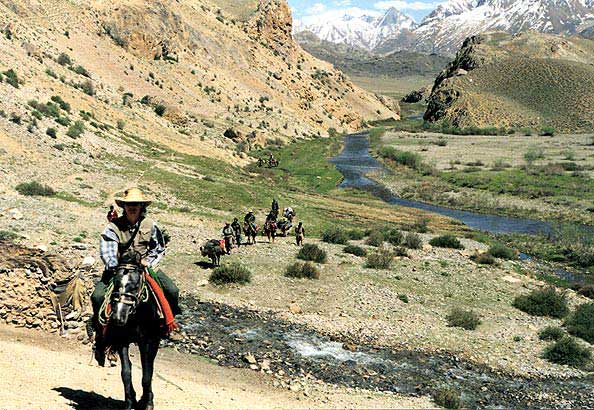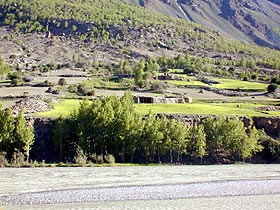


North-west Alpine Wetlands Complex The North-west Alpine Wetlands Complex essentially consists of a series of high altitude, interlinked, glacial, kettle and valley bottom lakes, marshes, peat bogs and braided stream beds in the Yarkhun Valley. The range in elevation of the wetlands extends from 2,600m in the southwest to 4,150m in the case of Lake Karumbar at the north-eastern extremity. The North-west Alpine Wetlands Complex, which is about 70 km long and up to 23 km wide, occupies an area of c. 1,760 square kilometer. The higher mountain peaks in the Complex, six of which are over 6,000m, have permanent snow accumulation zones, ice fields and glaciers.
The indigenous biodiversity of the valley has been poorly studied. Typical plant species in the western valley bottoms are Hippophae rhamnoides, Myricaria elegans, Poplus ciliata and Salix viminalis. Above the tree line, the dominant grasses are Festuca altaica and Poa attenuata. While there are year-round resident populations of wild vertebrates at lower elevations in the western sector of the valley, those in the eastern sector are either hibernating species such as the Golden Marmot (Marmota caudata aurea) or seasonal migrants such as the Marco Polo sheep (Ovis ammon). Flocks of migratory birds use the wetlands during the early and late summer periods.
 The communities in the eastern sector are predominantly Wakhi people — hardy pastoralists, whose settlements are snowbound for at least four months in the year. The principal source of subsistence in the eastern sector at elevations above 3,300m is seasonal pastoralism augmented by hunting of alpine ungulates and migratory waterfowl. Fuel for space heating and cooking is a major problem and emergent vegetation as well as peat in the marshes and around the lakes and stream beds is cut, dried, stored and burned. Essential livestock is maintained through the winter by stall-feeding. Fodder consists of mostly cut and dried emergent vegetation from alpine wetlands. Non-essential livestock are moved down the valleys in the winter to areas where the climate is milder. This leads to dense concentrations of domestic animals around the perennial water resources. Isolated water bodies, such as kettle lakes on perched plains, are almost completely denuded of peripheral and emergent vegetation by the end of the summer.
The communities in the eastern sector are predominantly Wakhi people — hardy pastoralists, whose settlements are snowbound for at least four months in the year. The principal source of subsistence in the eastern sector at elevations above 3,300m is seasonal pastoralism augmented by hunting of alpine ungulates and migratory waterfowl. Fuel for space heating and cooking is a major problem and emergent vegetation as well as peat in the marshes and around the lakes and stream beds is cut, dried, stored and burned. Essential livestock is maintained through the winter by stall-feeding. Fodder consists of mostly cut and dried emergent vegetation from alpine wetlands. Non-essential livestock are moved down the valleys in the winter to areas where the climate is milder. This leads to dense concentrations of domestic animals around the perennial water resources. Isolated water bodies, such as kettle lakes on perched plains, are almost completely denuded of peripheral and emergent vegetation by the end of the summer.